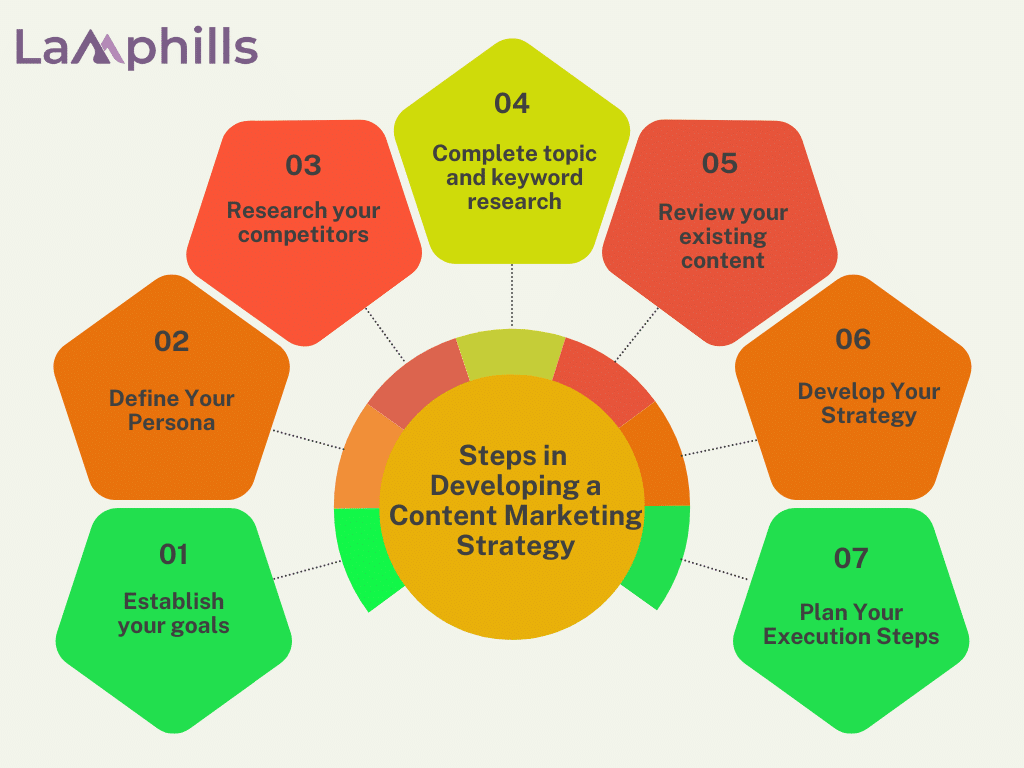The task of increasing website visitors when I founded my first startup overwhelmed me. I had an excellent product, but without visitors, it was like shouting into the empty. That’s when I realized the value of content marketing for startups. With the help of statistics and insights you won’t find on most websites, I’ll reveal the growth hacking techniques that can generate a ton of traffic in this article. Let’s go into content marketing for startups: growth hacking strategies for massive traffic.
What is Content Marketing?
Content marketing is the process of developing and disseminating useful, relevant content to attract, engage, and eventually convert a target audience into customers. Unlike traditional marketing, which frequently focuses on direct promotion, content marketing adds true value to consumers through useful or amusing content.
This technique establishes a closer relationship with the audience and increases trust and authority, both of which are important in creating long-term income. The goal is to extend beyond transactions and build a loyal and engaged customer base, enhancing each client’s lifetime value.
Key Takeaways
- By establishing clear goals, defining your target personas, and researching competitors, you can create a robust plan that drives traffic and engagement.
- Utilizing various content types, such as blogs, videos, podcasts, and infographics, caters to different audience preferences and expands your reach.
- Conduct thorough keyword research and optimize your content for search engines to increase visibility.
- Continuously monitor and analyze the performance of your content. Use tools to track key metrics like organic traffic, bounce rates, and social engagement.
- A structured approach helps in managing tasks effectively, meeting deadlines, and optimizing resources, leading to higher productivity and better content.
Why Should Startups Invest in Content Marketing?
Content marketing encompasses more than just blogging. It is a strategy for developing and disseminating valuable, relevant, and consistent content to attract and retain a certain audience. For startups, this can be a game changer, allowing them to increase brand awareness, drive traffic, and create leads without the large expenses required for traditional advertising.
Brand awareness can be increased at a low cost through content marketing.
For example, LiberEat, a food safety-focused digital firm, employed a content strategy to build its user base at the lowest feasible cost.
Within three months, they:
- Increased their organic traffic by 1000%.
- Increased organic conversions by 25%.
- Achieved sustained growth
Organic content, including blog posts, tutorials, lead magnets, and videos, can have a long-term influence. If properly maintained, this content can drive visitors to your firm for years.
Related paid advertising activities, such as targeted search and social ads, are also effective ways to reach certain demographics and can have a major short-term impact.
Effective content can assist you:
- Attract potential clients to your website and turn them into leads.
- Share reliable facts to build trust with your target audience.
- Make your brand more visible to your consumers by using SEO.
What are the Basic Steps in Developing a Content Marketing Strategy?

There’s a lot more to developing a content marketing strategy than just publishing various content pieces with your brand’s name on them.
A good content marketing strategy will rely on well-thought-out and implemented methods.
Before you can start planning those actions, you need to lay the groundwork for a content marketing strategy.
To begin your content marketing journey, you must first complete a few essential procedures to establish a solid foundation on which to develop.
#1. Establish your goals
Before you begin writing and uploading content, you must first determine your end goals.
Without specific goals, your content has a purpose, and there are no benchmarks for determining whether a piece of content is successful.
Begin by thinking broadly about what you want your content to achieve.
Is it to raise awareness for your brand? Or is it to educate readers on a certain aspect of your services?
Knowing what you want your content to accomplish allows you to focus your creative process and define success.
#2. Define Your Persona
Your personas are fictionalized versions of your ideal consumers.
Personas are used to help you define who you want to market to and why they would be interested in the items or services you have to offer.
By identifying your personas, you can target your audience and develop content that directly addresses their needs and desires.
Things to include in your personalities are:
- Demographic data (age, gender, location, etc.)
- Topics of Interest
- Personal and professional goals.
- Pain points
- Buying patterns
- Level of interest in your brand
- Needs and Wants
#3. Research your competitors
Knowing what content your competitors have had success with might be a wonderful place to begin content marketing for startups.
Rather than attempting to figure it out on your own, you may rely on others in your field to understand what works and what doesn’t with your target customers.
Researching your competition can save you time and money in the long run by avoiding time-consuming attempts that provide no returns.
It also helps you to set benchmarks for where your firm stands in contrast to competitors who have been in business longer than you.
#4. Complete topic and keyword research
As you begin your content marketing efforts, it may be difficult to decide what types of themes to focus on while developing content.
After all, there is a lot to talk about in your field!
Before you become frustrated with the procedure, take a step back. Consider the general themes that your target audience will be interested in, and then work your way down to more particular concepts.
You should also conduct keyword research to determine which search keywords people use to find information about your industry, brand, products, or services.
This might also help you narrow down the search terms to focus your content production on to obtain the most hits.
#5. Review your existing content
Even new startups have some previous content.
You can evaluate current content such as sales sheets, product descriptions, and website pages.
Reviewing your previous content might help you generate ideas and identify areas you’ve already addressed.
Examining your existing content can also help you identify any content quality concerns that need to be addressed, as well as a certain brand voice and style that you want to continue employing in future content pieces.
#6. Develop Your Strategy
After you’ve completed the initial research and planning for your content marketing, you can begin to create and implement your strategy.
Start by reviewing your content themes and deciding which ones you want to focus on initially.
You may then concentrate on developing a plan to create content pieces that align with your goals and target the personas you want to attract to your firm through content marketing.
#7. Plan Your Execution Steps
Once you’ve established your strategy framework, it’s time to go over the exact procedures required to carry out your strategy.
There are several factors to consider, including:
- Channels & Resources: Which channels will you employ to disseminate your content? Are you going to use social media, post on other trustworthy websites, or optimize your content for SEO?
Consider the various methods and resources you may utilize to distribute your content. - Content Marketing Sales Funnel: Content marketing should attract new audiences and guide them through your sales funnel until they become customers. Creating a smooth, seamless process for moving customers through your funnel is a vital component of growing your audience and acquiring new clients.
- Content Production Schedule: Your content should follow a production schedule. Without a well-planned timetable, you’re more likely to fall behind on content development and struggle to keep up. Creating a content calendar that specifies when content is developed and published might be extremely useful. Aside from a content calendar, you can rely on a team of ghostwriters to delegate the production of the articles, allowing you to deliver everything on time.
Types of Content Marketing for Startups
Different content formats cater to a wide range of audience tastes, allowing your firm to connect across multiple channels.
Let’s look at ten excellent content marketing kinds that every startup should explore.
#1. Blog Content Marketing
Blogs are the foundation of inbound marketing. Blog content is adaptable, SEO-friendly, and demonstrates knowledge.
Regularly blogging on relevant topics increases organic traffic, builds trust, and provides long-term value to readers.
Tips for a Successful Blog Content Strategy:
- Keyword Research: To target the most relevant keywords, use Ahrefs or Google Keyword Planner. These targeted terms ensure that your content reaches the intended audience. Create engaging headlines using CoSchedule’s Headline Analyzer. This tool promotes maximum clicks and engagement.
- Topical Depth: Prioritize thorough, in-depth content to improve SEO and authority.
- Include Visual Elements: Add photographs, infographics, or videos. These images improve readability and engagement.
- Internal linking: Internal linking improves SEO and engagement by connecting relevant blog entries. This simple action improves content discovery and authority.
- Post regularly: Consistency is essential. Make a content calendar and create a schedule. Then continue with it to keep your readers interested and attract new ones.
#2. Video Content Marketing
Visuals speak volumes! Create films that fascinate your audience, such as tutorials, product demos, seminars, or testimonials.
In fact, 87% of video marketers report that video content marketing has increased website traffic. (HubSpot)
Furthermore, videos engage numerous senses, creating an immersive experience. For example, they can communicate complex information more quickly and intuitively than text.
Videos allow for passive consumption, whereas written content needs active interaction. This method is better suited to fast-paced, visually oriented audiences.
Tips for a Successful Video Content Strategy
- Quality Editing: Use tools like Adobe Express or InShot to easily edit videos and achieve professional-quality results.
- Storytelling: Use clear tales to increase engagement and retention.
- Thumbnail: To attract viewers, use intriguing pictures.
- SEO Optimization: Use relevant keyword phrases, titles, and descriptions.
- Mobile Compatibility: Make sure your videos are mobile-friendly.
- Clear CTA: Include a call to action that directs viewers to their next steps.
- Increase Engagement: Encourage likes, shares, and comments.
- Shareability: Videos that are easy to share can help you reach more people across several platforms.
#3. Case Study Content Marketing
To get credibility, demonstrate real-world uses for your products or services.
Case studies can help your firm exhibit its successes, attract investors, and gain the trust of potential customers.
They also provide insights for internal teams, directing strategy through real-world outcomes.
Tips for a Successful Case Study Strategy
- Actual Results: Emphasize the tangible achievements and measurements obtained. Specific figures provide believability.
- Story Arc: Create case studies with a defined beginning, middle, and end. Make it engaging and relatable.
- Client Testimonials: Include real quotes from delighted clients to ensure credibility.
- Visual Data: Use charts, graphs, or infographics to display outcomes and make data more understandable.
- Clear CTA: Wrap up with a call to action. Direct readers on what to do next. For example, you may contact me, read another case study, or demonstrate a product.
#4. Email Marketing
Direct and personalized emails nurture leads and keep your brand top of your mind. From newsletters to promotions, customized emails increase conversions and loyalty.
According to HubSpot, the most effective email marketing campaign tactics are:
- Subscriber Segmentation (78%)
- Message personalization (72%).
- Email Automation Campaigns (71%).
Tips for a Successful Email Marketing Strategy
- Segmentation: Classify your subscribers depending on their activity or demographics. Then, modify your content for more relevancy.
- Catchy Subject Lines: Use captivating subject lines to increase open rates. A/B tests are also used to achieve the best outcomes.
- Responsive Design: Make your emails mobile-friendly. A sizable percentage of people read emails on mobile devices.
- Clear CTAs: Use different calls to action. Guide readers to the intended actions, such as purchasing or reading more.
- Analyze and iterate: Review analytics such as open and click-through rates regularly. Then, using statistics, alter your strategy to increase engagement.
#5. Podcast Content Marketing
Audio content, such as podcasts, has grown in popularity. Podcasts may establish you as a thought leader and broaden your reach.
You can share podcasts on social media, upload them to your website, or use hosting services like Apple Podcasts. They’re an excellent method to inform and interact with your target audience without being overtly commercial.
For example, look into industry trends, the latest news, or expert interviews. Then, apply these real-world insights to increase the value of your products or services.
Tips for a Successful Podcast Marketing Strategy
- Engaging names: Write catchy episode names that attract interest and convey content value.
- Guest Collaboration: Invite industry experts or influencers to expand your audience reach.
- Maintain a consistent release schedule of weekly or monthly episodes: This helps to keep and expand your listener base.
- Actionable Takeaways: Make sure each episode provides listeners with practical ideas or activities they can undertake.
- Encourage listeners to engage. Whether through feedback, suggestions for future episodes, or social media sharing.
Need easy-to-use podcast recording and editing software? Check out Audacity or Riverside.
#6. Infographic Content Marketing
Break down difficult information into accessible graphics. Infographics are both shareable and educational. They are ideal for presenting statistics, procedures, or comparisons.
In fact, infographics can increase website traffic by 12%. (Sprout Social.)
Tips for a Successful Infographic Strategy
- Data-Driven Insights: Use correct, up-to-date data to make your infographic informative and trustworthy.
- Visual Hierarchy: Create a clear flow. Smoothly transition visitors from the most crucial to the least important information.
- Consistent branding: Use your brand’s colors, typefaces, and logos to improve brand identification.
- Optimized Size and Format: Ensure that your infographic loads quickly and is readily shared.
- Embeddable Code: Include an embed code below the infographic. Make it easy for others to share.
Prioritizing these features will make your infographics more interesting, informative, and widely shared. Check out Canva and Picktochart to easily design one.
#7. Ebook Content Marketing
Ebooks excel in thought-leadership positioning by providing detailed insights. When utilized as lead magnets, they also collect valuable contact information for future marketing.
Startups strengthen their audience relationships by providing valuable content. The results increase trust, strengthen connections, and establish your brand as an industry expert.
Ebook Marketing Strategy Tips
- Targeted Topics: Determine and address your audience’s pain points or interests. Also, make sure the ebook remains relevant.
- Engaging Design: Improve your ebook’s visual appeal. Use a professional layout, high-quality photos, and consistent branding.
- Promotion Strategy: Use social media channels, email campaigns, and collaborations to increase your ebook’s visibility.
- Easy Accessibility: Provide a straightforward download mechanism, preferably in return for an email address.
Interactive elements include clickable links, embedded videos, and infographics. These increase involvement and offer additional benefits.
#8. Quiz Content Marketing
Engage and educate concurrently. Quizzes provide interactive content to help you segment your audience, collect statistics, and entertain. They are an effective instrument for engagement!
Quiz marketing also improves the user experience and encourages social sharing. Especially when you provide personalized results!
Maximize Your Quiz Marketing Strategy with These Tips
- Audience-Centric Topics: Customize quizzes to your audience’s interests and assure relevance.
- Personalized Feedback: Provide individualized results that resonate, driving sharing and repeat visits.
- Simple Design: Use user-friendly layouts and brief queries to encourage involvement.
- Data Collection: Use opt-ins to collect participant email addresses for future marketing initiatives.
Share your quiz on social media, email newsletters, and your website to increase reach and engagement.
Interactive quizzes are simple to implement. Check out plugins like Thrive Quiz Builder and websites like Typefom.
#9. Social Media Content Marketing
Social media is important for startups because it provides direct access to a large audience. It’s an efficient approach to raising brand recognition, promoting the community, and establishing trust.
Globally, 4.80 billion individuals utilize social media. This makes it a low-cost approach to creating leads and closing purchases.
Furthermore, shareable social content might promote viral development. This gives your startup a competitive advantage in congested markets.
Social Media Marketing Strategy Tips:
- Audience Research: Understand your target audience’s preferences and behaviors to personalize content successfully.
- Engaging Visuals: Use eye-catching images, movies, and graphics to draw attention.
- Consistent Posting: Stick to a regular posting schedule to keep followers interested and attract new ones.
- Interactive Content: Encourage two-way contact by using polls, quizzes, and Q&A sessions.
- Analyze and adapt: Monitor performance indicators and learn from feedback. Then, modify your strategy to achieve greater results.
#10. Whitepaper Content Marketing
A whitepaper provides detailed research or answers to industry-specific problems. These data-driven insights can help you generate high-quality prospects and establish your startup as a thought leader.
Whitepapers also increase credibility, establish trust with potential customers, and set your company apart from the competition.
Whitepaper Marketing Strategy Tips:
- Research-Driven Content: Base your whitepaper on credible data and industry research. Ensure accuracy and dependability.
- Clear Structure: Use a defined introduction, body, and conclusion. Use subheadings for easier navigation.
- Professional Design: Improve readability by using a basic layout, charts, and visuals. Make sure they are relevant and support the content.
- Avoid jargon and use concise language: Write in a language that your intended audience can comprehend.
- Promote your content via email, social media, and your website: Use them to capture leads through gated downloads.
I recall when I built a comprehensive SEO strategy for my startup’s blog. Within six months, our organic traffic doubled, and our leads increased by 30%. We achieved greater search engine rankings by focusing on long-tail keywords and updating our content regularly, resulting in increased traffic and conversions.
Using Templates for Consistency and Efficiency
Templates might help you streamline the content development process. A content marketing template can help you stay consistent and save time while ensuring your content is consistent with your brand’s voice and goals.
Example: A blog post template may have sections for an intriguing introduction, a main body with subheadings, and a convincing ending with a call to action. This allows you to structure your content properly and guarantees that all important components are included.
Conclusion
Content marketing for startups may be quite powerful when done correctly. Long-form content, user-generated content, SEO, and multimedia can all help you deliver a lot of traffic to your website. Personalize your approach and use templates to ensure consistency and efficiency. These methods helped me alter my startup’s online presence, and they may do the same for you.
Are you ready to utilize these growth-hacking secrets and elevate your startup’s content marketing to the next level? What tactics have you found to be most effective in driving traffic? Share your experiences and let’s learn from one another!
Related Articles
- Proven SaaS Content Marketing Tactics for Boosting Engagement and Conversions
- What is Content Syndication and Why You Should Start Using It Today
- 30+ Best Guest Blogging Sites to Submit Your Content in 2024
- Branded Content Marketing: The Powerful Strategy Big Brands Don’t Want You to Know
- How to Create Promotional Content That Drives Results for Your Brand(Plus Examples)





